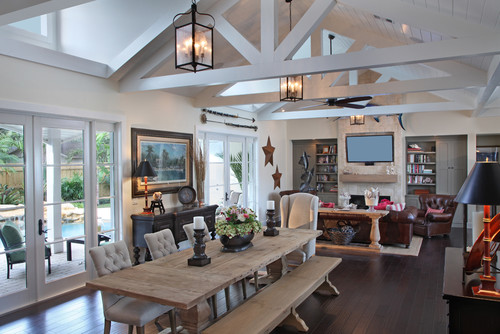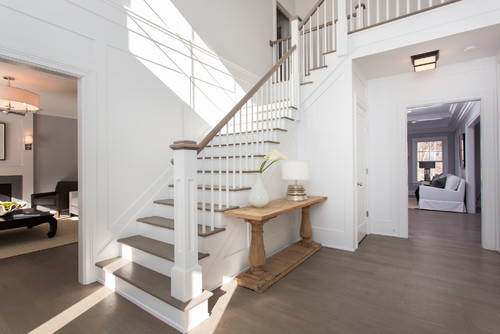Seems like the in thing right now is weathered gray furniture, and I have to admit that I am developing a fondness for it as well. I recently found a console at Restoration Hardware that I have been coveting, but it wasn’t exactly the gray color that I was hoping to find. I was looking for more of a dark driftwood tone. Plus, with a price of around $1700, I thought that this would be a good DIY project. I am sorry that I did not take photos of the whole process. However, I have created a sketch up to compensate.
Console Table Inspirations…
Here are a few images of the style I was going for, minus the gray finish. I’ll let you all be the judge on whether or not I achieved the look!

(Console table in the background – FYI that also looks like a RH dining table)

(A nice side view of Restoration Hardware’s console table)
Just an FYI:
I posted this project to help those who want to build something but do not have the equipment or skill required to create high end quality. The professional woodworker in me forces me to let you know that this is totally not the correct way to build a dining table or anything that you want to have and maintain a solid surface.
This particular plan is being done to demonstrate a quick and easy assembly of a rustic/farmhouse style. I am not concerned with this piece showing spaces between the seams. So, I am using pocket holes screws for the build.
If you want to create a piece that does not show the effects of wood movement overtime, you should use my professional method for table top construction. This project will eventually show seperation of the planks. I know and accept this upfront. But, you should also know this as well, and proceed with these instuctions only if you are wanting this type of look.
That being said, there is nothing wrong with building a console in this fashion. This table will hold up quite well for many years, and the structure is sound.
Tools and Supplies For This Project:
- Drill
- Pocket Hole Jig (I use Kreg Pocket Hole Jigs)
- Clamps
- Pocket Hole screws
- Wood screws
- Wood Glue
- Orbital Sander
- Chisel
- Hammer
- Utility Knife
- Paint Brush
- Rags
- Tack cloth
- Stain of choice (I used Minwax Dark Walnut, just because I had some left over)
- 2 shades of gray paint (one dark and one light)
- Wipe on Poly (I used the satin finish)
- (6) 2×6 pine boards cut to 5′
- (4) 2×6 pine boards cut to approximately 16″ (These are the end sections. Do not precut these. They should be cut to fit after assembling the 5′ sections).
- (2) 1×4 cut to 68″
- (2) 1×4 cut to 7″
- (2) wooden balusters – they come at around 20″ in height. I added wood blocks to raise mine to the height that I wanted, which was 23″. (I found these balusters on ebay, but Osborn’s carries a lot of table legs similar to this).
- (4) 8″ steel braces (available at Lowes and Home Depot)
Assembly Instruction…

Attach the Balusters…

Attach the Bottom and Top Foot/Braces…


(2) Attach the wooded support frame to the underside of the table’s bottom section using wood screws. (Sketch up shows the bottom view of the lower shelf).


(5) Angle the chisel on one side of the scored line and chisel the wood out towards the opposite line, working in the direction of the grain line


Stain and Paint:

For those of you who are curious about which colors I used for my paints, I used Sherwin William’s Urban Bronze (dark gray color) and Sherwin William’s Pavestone (Lighter gray). These are just some left over paints that I had on hand from painting the home theater room. So, feel free to go with something more to your taste.


Seal It
Finally, after it has been allowed to dry for 24 hours, you can add the sealer. (1) Using a lint free rag, work the Wipe on Poly in the direction of the wood grain. (2) Apply at least 2 coats, (I used 3 coats) allowing it to dry between each coat. Add some furniture felt pads to the bottom, if you have wood floors, and it is good to go!
Finished Product – My weathered Gray Console…

Feel free to share your own your own outcomes with this project!
(This post has been linked up with Remodelaholic and Savvy Southern Style).







Please keep it clean. Comments that do not follow the Comment's Policy may be removed.